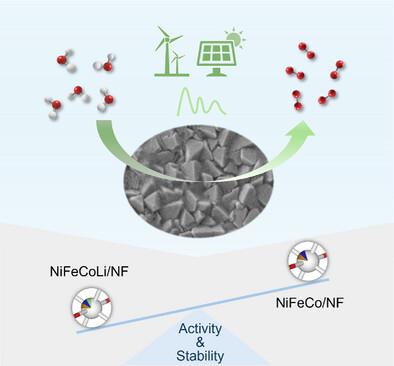Li‐Doping and Pyrolysis Engineered Robust Anode for Intermittency‐Resilient AEM Electrolysis
IF 26
1区 材料科学
Q1 CHEMISTRY, PHYSICAL
引用次数: 0
Abstract
The future of green hydrogen production via anion exchange membrane (AEM) water electrolysis lies in its integration with fluctuating renewable energy sources. However, the intermittent nature of renewables imposes stringent demands on the dynamic stability of highly active electrodes. To resolve this trade‐off between activity and stability of nickel‐based catalysts, this contribution describes a Li‐doping strategy coupled with pyrolysis to engineer a self‐supported nickel‐iron‐cobalt‐lithium oxide anode on nickel felt. Pyrolysis yields a dense, crystalline oxide lattice that is firmly anchored to the substrate, while Li incorporation induces lattice contraction and reinforces metal–oxygen bonds, significantly suppressing active metal dissolution. Simultaneously, Li‐driven electronic‐structure modulation enhances charge transfer and accelerates pre‐oxidation, collectively boosting oxygen evolution kinetics. The electrode achieves a low overpotential of 293 mV at 100 mA cm

间歇弹性AEM电解用Li掺杂和热解工程稳健阳极
阴离子交换膜(AEM)电解绿色制氢的未来在于与波动的可再生能源相结合。然而,可再生能源的间歇性对高活性电极的动态稳定性提出了严格的要求。为了解决镍基催化剂的活性和稳定性之间的权衡,本文描述了一种锂掺杂策略,结合热解技术,在镍毡上设计了一种自支撑的镍-铁-钴-锂氧化物阳极。热解产生致密的结晶氧化物晶格,牢固地固定在基体上,而Li的加入诱导晶格收缩并加强金属-氧键,显著抑制活性金属溶解。同时,锂驱动的电子结构调制增强了电荷转移,加速了预氧化,共同促进了析氧动力学。该电极在100 mA cm - 2下可实现293 mV的低过电位,在500 mA cm - 2下稳定工作500小时,衰减可以忽略不计,并且在模拟功率波动下表现出优异的弹性。在定制的AEM电解槽中,它在1.90 V时提供2000 mA cm - 2的高电流密度,在1000 mA cm - 2时表现出0.09 mV h - 1的低降解率,并且可以承受60秒启动/停止操作100小时(3000个循环)。这项工作为加速绿色氢的发展提供了一条引人注目的途径,通过工程电极将有利的活性与强大的耐用性结合起来,实现与具有成本效益的间歇性可再生能源的无缝集成。
本文章由计算机程序翻译,如有差异,请以英文原文为准。
求助全文
约1分钟内获得全文
求助全文
来源期刊

Advanced Energy Materials
CHEMISTRY, PHYSICAL-ENERGY & FUELS
CiteScore
41.90
自引率
4.00%
发文量
889
审稿时长
1.4 months
期刊介绍:
Established in 2011, Advanced Energy Materials is an international, interdisciplinary, English-language journal that focuses on materials used in energy harvesting, conversion, and storage. It is regarded as a top-quality journal alongside Advanced Materials, Advanced Functional Materials, and Small.
With a 2022 Impact Factor of 27.8, Advanced Energy Materials is considered a prime source for the best energy-related research. The journal covers a wide range of topics in energy-related research, including organic and inorganic photovoltaics, batteries and supercapacitors, fuel cells, hydrogen generation and storage, thermoelectrics, water splitting and photocatalysis, solar fuels and thermosolar power, magnetocalorics, and piezoelectronics.
The readership of Advanced Energy Materials includes materials scientists, chemists, physicists, and engineers in both academia and industry. The journal is indexed in various databases and collections, such as Advanced Technologies & Aerospace Database, FIZ Karlsruhe, INSPEC (IET), Science Citation Index Expanded, Technology Collection, and Web of Science, among others.
 求助内容:
求助内容: 应助结果提醒方式:
应助结果提醒方式:


